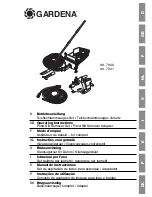
24
MAX-E-THERM
®
Pool and Spa Heater Installation and User’s Guide
P/N S794 Rev. H 8-11-14
Section 2. Installation
WARNING
Risk of carbon monoxide poisoning if adapter is improperly attached.
Mechanical connections (such as screws) can
cause cracking and leaks in the adapter. Do
NOT
drill holes or use screws to connect the appliance adapter to the heater vent
body. Attach with manufacturer’s specified adhesive.
WARNING
Risk of fire or asphyxiation if vent is not assembled according to manufacturer’s instructions or if vent parts from
different manufacturers are mixed.
Vent parts from different manufacturers ARE NOT interchangeable. Mixing parts from
more than one manufacturer may cause leaks or damage to vent. When installing a vent, pick one manufacturer and be sure
that all vent parts come from that manufacturer and are specified by the manufacturer for your system. Follow manufacturer’s
instructions and local and National Fuel Gas Code (U.S.) or CSA B149.1, Natural Gas and Propane Installation Codes
(Canada) requirements carefully during assembly and installation.
4. Install vent pipe so that it can expand and contract freely
as the temperature changes. Support the vent pipe
according to applicable codes and vent manufacturer’s
instructions. Pipe support must allow the vent pipe free
movement out and back, from side to side, or up and
down as necessary, without putting a strain on the heater
or vent body. It is recommended to slope the horizontal
pipe runs up from the heater at least 1/4" per foot (2cm/M).
Install “Approved” condensate drains at low points where
condensate might collect. Plumb condensate drains to a
drain through hard piping or high-temperature tubing such
as silicone rubber or EPDM rubber – do not use vinyl or
other low temperature tubing. Follow drain
manufacturer’s installation instructions.
5. Use an “Approved” firestop for floor and ceiling
penetrations. Use an “Approved” thimble for wall
penetrations. Use an “Approved” roof flashing, roof jack,
or roof thimble for all roof penetrations. Do not fill the
space around the vent (that is, the clear air space in the
thimble or firestop) with insulation. The roof opening must
be located so that the vent is vertical.
6.
Vent Termination – Vertical
(See
Figures 16
and
17
),
for height of vent termination above the roof. Use an
“Approved” vent terminal specified by local and national
codes and your manufacturer’s instructions. A roof
termination must be vertical. In Canada, the Vent Cap
location shall have a minimum clearance of 4 feet (1.2M)
horizontally from electric meters, gas meters, regulators,
and relief openings.
7. Make sure entire installation is sealed according to
approved standard.
Outlet Air
Opening
Inlet Air
Opening
Chimney or Gas Vent
Vent Cap and
Riser Furnished
by Installer
Side
Wall Vent
Heater
Heater
Chimney or Gas Vent
Vent Cap and
Riser Furnished
by Installer
Side
Wall Vent
Outlet Air Opening
Inlet Air Opening
Figure 16.
Figure 17.
















































